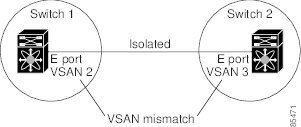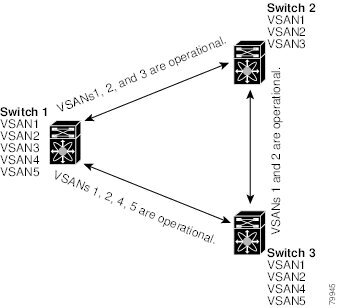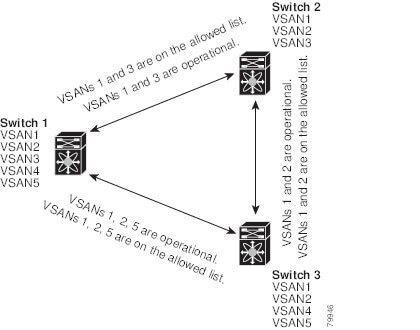

-
Cisco Nexus 5500 Series NX-OS SAN Switching Configuration Guide, Release 7.x
-
Preface
-
Overview
-
Configuring Fibre Channel Interfaces
-
Configuring Fibre Channel Domain Parameters
-
Configuring N Port Virtualization
-
Configuring FCoE NPV
-
Configuring VSAN Trunking
-
Configuring SAN Port Channels
-
Configuring and Managing VSANs
-
Configuring and Managing Zones
-
Distributing Device Alias Services
-
Configuring Fibre Channel Routing Services and Protocols
-
Managing FLOGI, Name Server, FDMI, and RSCN Databases
-
Discovering SCSI Targets
-
Configuring iSCSI TLV
-
Advanced Fibre Channel Features
-
Configuring FC-SP and DHCHAP
-
Configuring Port Security
-
Configuring Fabric Binding
-
Configuring Fabric Configuration Servers
-
Configuring Port Tracking
-
Index
-
Contents
- Configuring VSAN Trunking
- Configuring VSAN Trunking
- Information About VSAN Trunking
- VSAN Trunking Mismatches
- VSAN Trunking Protocol
- Configuring VSAN Trunking
- Guidelines and Limitations
- Enabling or Disabling the VSAN Trunking Protocol
- Trunk Mode
- Configuring Trunk Mode
- Trunk-Allowed VSAN Lists
- Configuring an Allowed-Active List of VSANs
- Displaying VSAN Trunking Information
- Default Settings for VSAN Trunks
Configuring VSAN Trunking
This chapter describes how to configure VSAN trunking.
This chapter includes the following sections:
Configuring VSAN Trunking
Information About VSAN Trunking
VSAN trunking enable interconnected ports to transmit and receive frames in more than one VSAN. Trunking is supported on E ports and F ports.
Beginning in Cisco NX-OS Release 5.0(2)N1(1), VSAN trunking is supported on native Fibre Channel interfaces and virtual Fibre Channel interfaces.
The VSAN trunking feature includes the following restrictions:
- Trunking configurations are applicable only to E ports. If trunk mode is enabled in an E port and that port becomes operational as a trunking E port, it is referred to as a TE port.
- The trunk-allowed VSANs configured for TE ports are used by the trunking protocol to determine the allowed-active VSANs in which frames can be received or transmitted.
- If a trunking-enabled E port is connected to a third-party switch, the trunking protocol ensures seamless operation as an E port.
VSAN Trunking Mismatches
If you misconfigure VSAN configurations across E ports, issues can occur such as the merging of traffic in two VSANs (causing both VSANs to mismatch). The VSAN trunking protocol validates the VSAN interfaces at both ends of an ISL to avoid merging VSANs (see the following figure).
In this example, the trunking protocol detects potential VSAN merging and isolates the ports involved.
The trunking protocol cannot detect merging of VSANs when a third-party switch is placed in between two Cisco SAN switches (see the following figure).
VSAN 2 and VSAN 3 are effectively merged with overlapping entries in the name server and the zone applications. Cisco MDS 9000 Fabric Manager helps detect such topologies.
VSAN Trunking Protocol
The trunking protocol is important for E-port and TE-port operations. It supports the following capabilities:
- Dynamic negotiation of operational trunk mode.
- Selection of a common set of trunk-allowed VSANs.
- Detection of a VSAN mismatch across an ISL.
By default, the VSAN trunking protocol is enabled. If the trunking protocol is disabled on a switch, no port on that switch can apply new trunk configurations. Existing trunk configurations are not affected: the TE port continues to function in trunk mode but only supports traffic in VSANs that it negotiated with previously (when the trunking protocol was enabled). Other switches that are directly connected to this switch are similarly affected on the connected interfaces. If you need to merge traffic from different port VSANs across a nontrunking ISL, disable the trunking protocol.
Configuring VSAN Trunking
Guidelines and Limitations
When configuring VSAN trunking, note the following guidelines:
- We recommend that both ends of a VSAN trunking ISL belong to the same port VSAN. On platforms or fabric switches where the port VSANs are different, one end returns an error, and the other is not connected.
- To avoid inconsistent configurations, disable all E ports with a shutdown command before enabling or disabling the VSAN trunking protocol.
Enabling or Disabling the VSAN Trunking Protocol
ProcedureTrunk Mode
By default, trunk mode is enabled in all Fibre Channel interfaces. However, trunk mode configuration takes effect only in E-port mode. You can configure trunk mode as on (enabled), off (disabled), or auto (automatic). The default trunk mode is on. The trunk mode configurations at the two ends of the link determine the trunking state of the link and the port modes at both ends (see the following table).
Table 1 Trunk Mode Status Between Switches Your Trunk Mode Configuration
Resulting State and Port Mode
Switch 1
Switch 2
Trunking State
Port Mode
On
Auto or on
Trunking (EISL)
TE port
Off
Auto, on, or off
No trunking (ISL)
E port
Auto
Auto
No trunking (ISL)
E port
The preferred configuration on the Cisco SAN switches is that one side of the trunk is set to auto and the other is set to on.
Note
When connected to a third-party switch, the trunk mode configuration has no effect. The Inter-Switch Link (ISL) is always in a trunking disabled state.
Configuring Trunk Mode
ProcedureEXAMPLES
This example shows how to configure a vFC interface in trunk mode:
switch# configure terminal switch#(config)# vfc 200 switch(config-if)# switchport trunk mode onThis example shows the output for the vFC interface 200 in trunk mode:
switch(config-if)# show interface vfc200 vfc200 is trunking (Not all VSANs UP on the trunk) Bound interface is Ethernet1/3 Hardware is Virtual Fibre Channel Port WWN is 20:c7:00:0d:ec:f2:08:ff Peer port WWN is 00:00:00:00:00:00:00:00 Admin port mode is E, trunk mode is on snmp link state traps are enabled Port mode is TE Port vsan is 1 Trunk vsans (admin allowed and active) (1-6,10,22) Trunk vsans (up) () Trunk vsans (isolated) () Trunk vsans (initializing) (1-6,10,22) 5 minute input rate 0 bits/sec, 0 bytes/sec, 0 frames/sec 5 minute output rate 0 bits/sec, 0 bytes/sec, 0 frames/sec 0 frames input, 0 bytes 0 discards, 0 errors 0 frames output, 0 bytes 0 discards, 0 errors last clearing of "show interface" counters never Interface last changed at Mon Jan 18 10:01:27 2010Trunk-Allowed VSAN Lists
Each Fibre Channel interface has an associated trunk-allowed VSAN list. In TE-port mode, frames are transmitted and received in one or more VSANs specified in this list. By default, the complete VSAN range (1 through 4093) is included in the trunk-allowed list.
The common set of VSANs that are configured and active in the switch are included in the trunk-allowed VSAN list for an interface, and they are called allowed-active VSANs. The trunking protocol uses the list of allowed-active VSANs at the two ends of an ISL to determine the list of operational VSANs in which traffic is allowed.
In the following figure, switch 1 has VSANs 1 through 5, switch 2 has VSANs 1 through 3, and switch 3 has VSANs 1, 2, 4, and 5 with a default configuration of trunk-allowed VSANs. All VSANs configured in all three switches are allowed-active. However, only the common set of allowed-active VSANs at the ends of the ISL become operational as shown in below.
You can configure a selected set of VSANs (from the allowed-active list) to control access to the VSANs specified in a trunking ISL.
Using the figure above as an example, you can configure the list of allowed VSANs on a per-interface basis (see the following figure). For example, if VSANs 2 and 4 are removed from the allowed VSAN list of ISLs connecting to switch 1, the operational allowed list of VSANs for each ISL would be as follows:
- The ISL between switch 1 and switch 2 includes VSAN 1 and VSAN 3.
- The ISL between switch 2 and switch 3 includes VSAN 1 and VSAN 2.
- The ISL between switch 3 and switch 1 includes VSAN 1, 2, and 5.
VSAN 2 can only be routed from switch 1 through switch 3 to switch 2.
Configuring an Allowed-Active List of VSANs
Procedure
Command or Action Purpose
Step 1 configure terminal
Example:switch# configure terminal switch(config)#Enters global configuration mode.
Step 2 switchport trunk allowed vsan vsan-id - vsan-id
Example:switch(config-if)# switchport trunk allowed vsan 35-55Changes the allowed list for the specified VSAN range.
Step 3 switchport trunk allowed vsan add vsan-id
Example:switch(config-if)# switchport trunk allowed vsan add 40Expands the specified VSAN to the new allowed list.
Step 4 no switchport trunk allowed vsan vsan-id - vsan-id
Example:switch(config-if)# no switchport trunk allowed vsan 61-65Deletes the specified VSAN range.
Step 5 no switchport trunk allowed vsan add vsan-id
Example:switch(config-if)# no switchport trunk allowed vsan add 40Deletes the expanded allowed list.
Displaying VSAN Trunking Information
The show interface command is invoked from the EXEC mode and displays VSAN trunking configurations for a TE port. Without any arguments, this command displays the information for all of the configured interfaces in the switch.
The following example shows how to display the trunk mode of a Fibre Channel interface:
switch# show interface fc3/3fc3/3 is upHardware is Fibre Channel, SFP is short wave laser w/o OFC (SN)Port WWN is 20:83:00:0d:ec:6d:78:40Peer port WWN is 20:0c:00:0d:ec:0d:d0:00Admin port mode is auto, trunk mode is on...The following example shows how to display the trunk protocol of a Fibre Channel interface:
switch# show trunk protocolTrunk protocol is enabledThe following example shows how to display the VSAN information for all trunk interfaces:
switch# show interface trunk vsan 1-1000fc3/1 is not trunking...fc3/11 is trunkingBelongs to san-port-channel 6Vsan 1 is up, FCID is 0xef0000Vsan 2 is up, FCID is 0xef0000...san-port-channel 6 is trunkingVsan 1 is up, FCID is 0xef0000Vsan 2 is up, FCID is 0xef0000

 Feedback
Feedback



